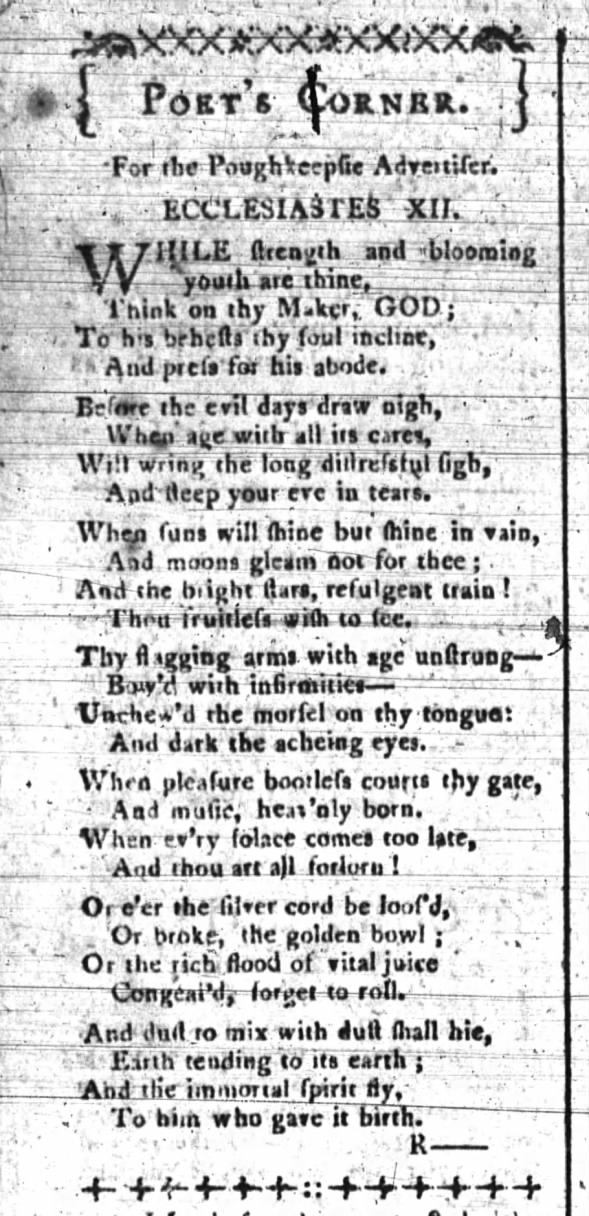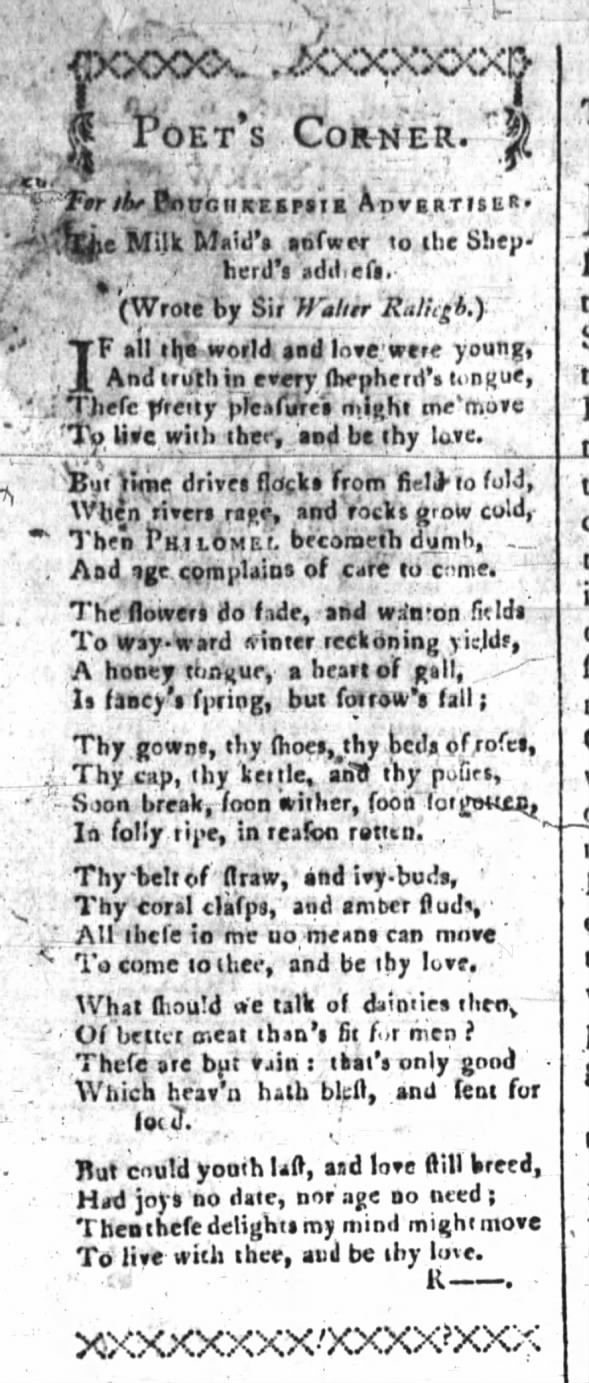- An Invitation to the Country - January 19, 1786 (anonymously published).
- Ecclesiastes XII - March 23, 1786 (signed, "R——.").
- The Vine and Oak. A Fable. - May 4, 1786 (anonymously published).
- On the Late Mr. Gilbert Cortlandt - December 6, 1786 (signed, "R——.").
 · Thu, Jan 19, 1786 – Page 4 · Poughkeepsie Journal (Poughkeepsie, New York) · Newspapers.com
· Thu, Jan 19, 1786 – Page 4 · Poughkeepsie Journal (Poughkeepsie, New York) · Newspapers.com
 · Thu, Mar 23, 1786 – Page 4 · Poughkeepsie Journal (Poughkeepsie, New York) · Newspapers.com
· Thu, Mar 23, 1786 – Page 4 · Poughkeepsie Journal (Poughkeepsie, New York) · Newspapers.com
Two of the four 1786 poems, "Invitation to the Country" and "Vine and Oak" appeared anonymously; two are subscribed "R——." Versions of three (all except "Eccleisastes XII") in the handwriting of Henry Livingston, Jr. appear in Livingston's manuscript book of poetry, accessible online via the Henry Livingston website created by Mary S. Van Deusen.
"Invitation to the Country" is early, only the third poem in Livingston's manuscript book. The first, titled "Easter," is dated 1784 and may have appeared in a newspaper that is no longer extant.
On January 24, 1787 The Country Journal and the Poughkeepsie Advertiser published a version of Christopher Marlowe's Passionate Shepherd under the title "The Shepherd's Address to the Milk Maid." The poem appeared without any mention of Marlowe in the regular "Poet's Corner" column, submitted "For the POUGHKEEPSIE ADVERTISER" by "R——." A brief headnote names Shakespeare as the widely accepted author of The Shepherd's Address, and promises to give Walter Ralegh's answering poem "in the next number of this paper." The attribution of "The Shepherd's Address" to Shakespeare follows Warburton, cited for instance by Samuel Johnson in a footnote to The Merry Wives of Windsor (where Shakespeare in Act 3 Scene 1 makes Sir Hugh Evans sing bits from the second and third stanzas of Marlowe's poem). The certainty with which the second poem is scheduled to appear in print, indicates the headnote may have been added by the editor rather than the contributor "R——."
During the previous year the Poughkeepsie newspaper published four poems that appear in Livingston's book of manuscript poetry, two signed "R——." The year before that (October 13, 1785), prose advice To the Farmers, evincing Livingston's style of writing and passion for agriculture, was published over the same signature, "R——." Perhaps not coincidentally, Henry Livingston's interest in poetry and specifically in pastoral love poetry coincides with the latter years of bachelorhood he experienced as a widower, before his second marriage in 1793 to Jane McLean Patterson. The choice of "R" remains unexplained. Nevertheless, in view of demonstrable connections between Livingston's manuscript book and published items from "R" in the years from 1785 to 1790 or so, it seems likely that Henry Livingston, Jr. contributed "Ecclesiastes XII" in March 1786 and, early in 1787, both the "Shepherd's Address" and "Milk Maid's Answer" for the "Poet's Corner" of the Country Journal and the Poughkeepsie Advertiser. Livingston deserves credit for supplying texts reproduced in these early (maybe even the first?) American printings of the "Passionate Shepherd" and "Nymph's Reply."
 · Wed, Jan 24, 1787 – Page 4 · Poughkeepsie Journal (Poughkeepsie, New York) · Newspapers.com
· Wed, Jan 24, 1787 – Page 4 · Poughkeepsie Journal (Poughkeepsie, New York) · Newspapers.com
As promised, "The Milk Maid's Answer to the Shepherd's address" aka The Nymphs Reply did in fact appear the following week, also submitted by "R——." In parentheses, somebody--either "R——." or the editor--correctly ascribed the poem to Walter Ralegh, here spelling it Raliegh.
 · Wed, Jan 31, 1787 – Page 4 · Poughkeepsie Journal (Poughkeepsie, New York) · Newspapers.com
· Wed, Jan 31, 1787 – Page 4 · Poughkeepsie Journal (Poughkeepsie, New York) · Newspapers.com
Both poems were published together in the "Poetry" column of the Poughkeepsie Journal on December 6, 1803. The titles have been standardized as "The passionate Shepherd to his love" and "The Nymphs reply to the Shepherd," losing the milkmaids referenced in the headnotes to the 1787 versions. But as in 1787, Marlowe's "Passionate Shepherd" is still attributed to Shakespeare.
 · Tue, Dec 6, 1803 – Page 4 · Poughkeepsie Journal (Poughkeepsie, New York) · Newspapers.com
· Tue, Dec 6, 1803 – Page 4 · Poughkeepsie Journal (Poughkeepsie, New York) · Newspapers.com

No comments:
Post a Comment